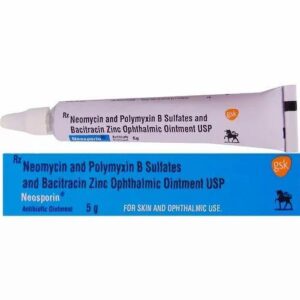POLYMYXIN B + NEOMYCIN + ZINC BACITRACIN
Polymyxin B: Polymyxin B is an antibiotic drug that belongs to the polymyxin class of medications. It is mainly used to treat various bacterial infections, particularly those caused by gram-negative bacteria. It is often reserved for severe infections that do not respond to other antibiotics due to its potential toxicity.
The mechanism of action of Polymyxin B involves binding to the bacterial cell membrane, disrupting its structure, and causing leakage of intracellular contents. This ultimately leads to the death of the bacteria. Polymyxin B specifically targets gram-negative bacteria by interacting with lipopolysaccharides on their outer membrane.
The drug is usually administered intravenously. The recommended dose of Polymyxin B depends on several factors such as the severity of the infection, patient’s weight, and renal function. It is typically dosed two to four times a day, with each dose usually ranging from 5,000 to 25,000 units per kilogram of body weight.
Like all medications, Polymyxin B can cause side effects. Common side effects include pain at the injection site, fever, rash, and itching. It can also cause kidney damage, neurotoxicity (including dizziness and numbness), and respiratory distress in some cases. Due to its potential toxicity, the use of Polymyxin B requires careful monitoring of kidney function and close observation for any adverse reactions.
Neomycin: Neomycin is an antibiotic drug that belongs to the aminoglycoside class of drugs. It is commonly used to treat bacterial infections, particularly those caused by Gram-negative bacteria. Neomycin is commonly found in topical preparations, including creams, ointments, and eye drops, but it can also be taken orally or administered intravenously in certain cases.
Neomycin works by inhibiting protein synthesis in bacteria, thereby disrupting their ability to grow and reproduce. It achieves this by binding to the bacterial ribosomes, which are responsible for protein synthesis, and interfering with the process.
The specific dosage of neomycin will vary depending on the route of administration, the severity of the infection, and other individual factors. For topical use, neomycin is typically applied to the affected area three to four times a day. For oral or intravenous use, the dosage is usually calculated based on the patient’s weight and given at regular intervals throughout the day.
While neomycin is effective against many bacterial infections, it is known to have several potential side effects. Common side effects include skin irritation or allergic reactions at the site of application, diarrhea, nausea, and vomiting. In rare cases, neomycin can cause severe allergic reactions, kidney damage, or nerve damage. There is also a risk of developing antibiotic resistance with prolonged or inappropriate use of neomycin.
It is important to note that neomycin should not be used in individuals with a known allergy to aminoglycoside antibiotics and should be used with caution in patients with kidney problems or hearing impairment. Additionally, neomycin can interact with certain medications and substances, so it is important for individuals to inform their healthcare provider about all the medications they are taking before starting neomycin treatment.
Zinc Bacitracin: Zinc Bacitracin is a combination drug that contains the antibiotic bacitracin and the mineral zinc. It is commonly used as a topical ointment to prevent or treat bacterial infections of the skin.
The antibiotic component, bacitracin, inhibits the growth and replication of bacteria by interfering with the synthesis of their cell walls. It primarily targets Gram-positive bacteria such as Staphylococcus and Streptococcus species.
Zinc, a trace mineral, is added to the formulation due to its beneficial properties in wound healing. Zinc helps to enhance cellular repair processes, reduce inflammation, and promote tissue regeneration.
As a topical agent, Zinc Bacitracin ointment is typically applied directly to the affected area of the skin. The exact dose and frequency of application may vary depending on the severity of the infection and the healthcare provider’s instructions. It is important to clean and dry the affected area before applying the ointment.
Like any medication, Zinc Bacitracin may cause side effects, although they are usually minimal when used topically. Some possible side effects may include skin irritation, rash, redness, itching, or allergic reactions. If any of these side effects occur and persist, it is recommended to discontinue the use of the medication and consult a healthcare professional.
It is worth noting that Zinc Bacitracin should be used specifically for bacterial infections and should not be used for viral or fungal infections. Additionally, it is not recommended for use in large open wounds or on mucous membranes, as it can be absorbed systemically and potentially lead to adverse effects.
As with any medication, it is important to consult a healthcare professional before using Zinc Bacitracin to ensure it is appropriate for the specific condition and to discuss any potential drug interactions or allergies.

